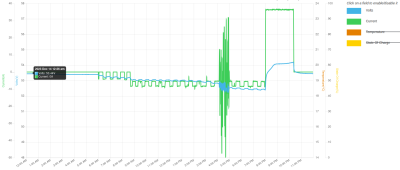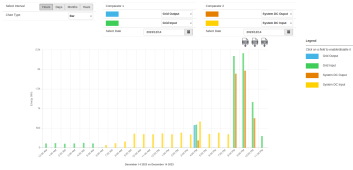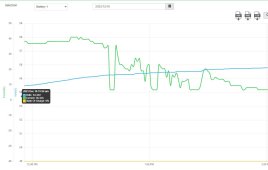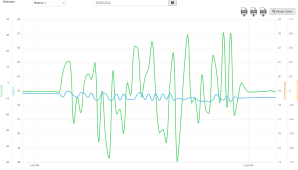@ohsolar From your graph, it looks like the XW sent just 0.62 KWHs to your main panel on that one day. That is very small indeed. What loads are in your main panel? That could be 620 watts for one hour, That could show as an export. Or it could have been 62 watts for 10 hours. That would be a lot less likely to show at the grid. Or if you hit the wrong setting in the XW, it could even have been just 10 minutes, but pushing a healthy 3,720 watts. The grid would certainly see that.
Go to your battery summary page on Insight Local. Pick that date Dec. 14th and look at your battery discharge current graph. How far negative does it go, and for how long? Here is mine for the same Dec 14th day.

The green trace is battery current. My largest inverter power happened just before 9 pm. The current went to -44 amps for 2 minutes. I think that was the microwave oven and the toaster at the same time. Or maybe my girlfriend used her hair dryer. In any case, the XW had to invert 54 volts x 44 amps = 2,376 watts to keep up with the loads in my house at that moment. You can see how that yanked the battery voltage down too. In my case, I do have my own export limiting setup. I have it set so I am exporting 20 watts to grid most of the day, and up to 80 watts when the Enphase solar is making more than I need. The XW charged from Enphase power from 8:22 am to 3:32 pm. But I used a little grid powe after 2 pm because it only goes down to 7 amps of charge current when clouds/night moves in. At 3:30 I let it stop charging and start doing grid support and seel to grid. So it goes right from 7 amps of charging to 5 amps of discharging into the inverter.
The "Energy Comparison" page might also show you what hour it happened in. Since I have the AC coupled Enphase inverters, the Grid Sell stats also include all of the power that goes through the XW to get to the grid. That is how it shows me discharging more power than I charge. The XW does not see the power from my DC solar controller.
Here i my Energy Comparison. It only sows a single number for the whole hour, so you don't get the detail of the battery summary, but it can give you a lot more data.
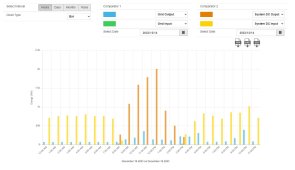
Here you can see that I was only putting energy into the battery from in the 8 am hour to the 3 pm hour with the orange bars. The yellow bars are the energy coming back out of the batteries. That floats between 700 an 800 watts this time of year. The blue bars shows that power l have been inverting is almost always exporting a little to grid. But it is only 69 watts for the first few hours. When the PV solar takes over, the export goes up, because the XW is seeing the power going through it from output back to the grid. At this point, the XW is charging, not inverting.Gren is power coming in from the grid. There is not much on that graph. Just a iny bit at 8 am and 3 pm. This happens when te PV current falls below the house demand and the minimum 7 amp charge current. Rather than stop / start charging, this is "Super off Peak" time, so I just let it pull that grid current during the transitions.
Here is how this all looked from Southern California Edison.
Unlike
@n2aws I have mine set to always export a little since I do have a net metering deal which is pretty good.
But I still keep it very low, I want to keep power in the battery for the whole night until the next sunrise, or a grid failure.

This is basically the data from the grid power meter at my house. You can easily see the 20 watts of export the whole time I am running on battery. And when the sun was up, I le it export to just over 100 watts. Again at 3 pm, here you can see I bought the super off peak power, but only 140 watts averaged over the hour. Total for the day ended up exporting 770 watt hours, or 0.77 KWHs. Very little. As the sun was going down, the Enphase system was not covering the loads AND the 7 amps of battery charge current. In the past, I would have it turn off charging right away, but I figured it was better to get some energy into the battery on these short solar days. When the days are longer, and the sun falls after 4 pm, then it will stop charging right away, so I don't buy any of the on peak power from 4 pm to 9 pm.
If your electric company will supply you with hourly charts like that, you can see exactly where you are using or exporting too much power. This is different from the XW-Pro grid energy graph because of the power used in my main panel. Most of the time, that was only 50 watts. All my normal running loads are in my backup panel, so they are covered by the inverter power output. I didn't have it graph that, but you can pick that on the Energy Comparison page.








